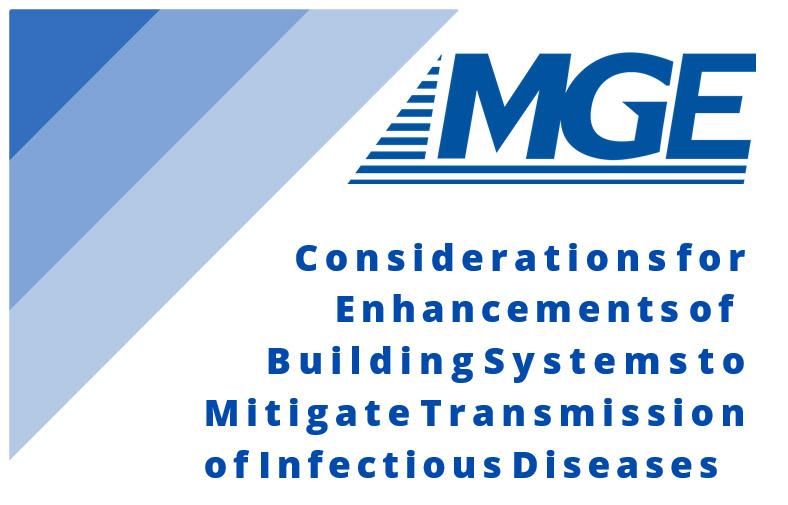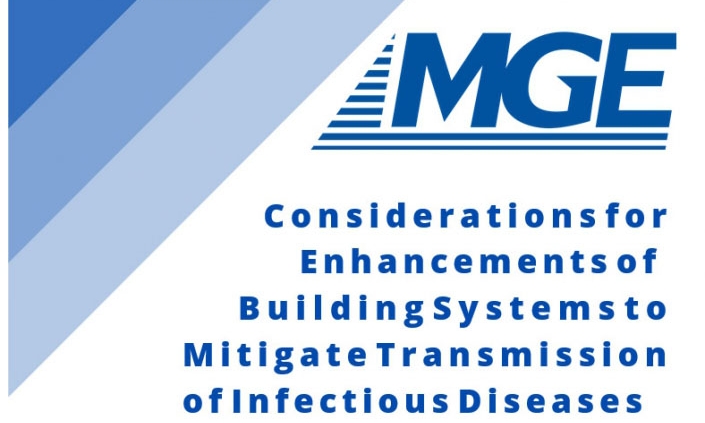MGE CONSIDERATIONS FOR ENHANCEMENTS OF BUILDING SYSTEMS TO MITIGATE TRANSMISSION OF INFECTIOUS DISEASES

CONSIDERATIONS FOR ENHANCEMENTS OF BUILDING SYSTEMS TO MITIGATE TRANSMISSION OF INFECTIOUS DISEASES
“MGE will continue to evolve our response to this pandemic in order to best support our clients and the community.”
Michael Gerazounis, P.E.
President / Managing Principal
Introduction
The current pandemic crisis has led to a massive shift in everyday life, and as such there is an expectation that building design, operations and maintenance must follow suit. Integrated approaches to creating safer and healthier buildings are now at the forefront of the architecture, engineering, technology and construction industries even more than ever before. MG Engineering D.P.C. (MGE) in concert with our technology company MGE Unified Technologies Corp (UTC) has been working closely with the real estate industry to respond to this pandemic and support our clients and the community in a fashion that provides practical solutions to their respective needs. We offer this position paper which addresses building systems, including HVAC, lighting and technology which combined with building operations and protocols can help direct our clients towards approaches that may help mitigate transmission of pathogens within buildings.
Many of the recommendations are based on findings and direction of the Center for Disease Control (CDC) and ASHRAE.
Background
The CDC is responding to a pandemic of respiratory disease spreading from person to person caused by a novel (new) coronavirus. The disease has been named “coronavirus disease 2019” (abbreviated “COVID-19”). This situation poses a serious public health risk. The federal government is working closely with state, local, tribal, and territorial partners as well as public health partners, to respond to this situation. COVID-19 can cause mild to severe illness; most severe illness occurs in adults 65 years and older and people of any age with serious underlying medical problems.
Coronaviruses are a large family of viruses that are common in people and many different species of animals, including camels, cattle, cats, and bats. Rarely, animal coronaviruses can infect people and then spread between people such as with MERS-CoV, SARS-CoV, and now with this new virus, named SARS- CoV-2.
The risk posed by COVID-19 depends on characteristics of the virus, including how easily it spreads between people; the severity of resulting illness; and the medical or other measures available to control the impact of the virus (for example, vaccines or medications that can treat the illness) and the relative success of these. Since there are not yet vaccines or treatments for COVID-19, non-pharmaceutical interventions become the most important response strategy. These are community interventions that can help reduce the impact of disease, like social distancing and good hand hygiene.
SARS-CoV-2 Transmission
COVID-19 is thought to spread mainly through close contact from person-to-person in
respiratory droplets from someone who is infected. People who are infected often have symptoms of illness. Some people without symptoms may be able to spread virus.
Person-to-Person spread can occur in the following fashions:
- Between people who are in close contact with one another (within about 6 feet).
- Through respiratory droplets produced when an infected person coughs, sneezes or talks. Droplets may not linger long in the airstream. However, possible transmission through smaller aerosol particles is possible. Generally, the larger particles fall out of the airstream more quickly due to gravity.
- These droplets can land in the mouths or noses of people who are nearby or possibly be inhaled into the lungs.
- Through physical contact (usually by hand) with surfaces that contain the virus and then transmitting into the body by touching the face (eyes, nose or mouth).
Some recent studies have suggested that COVID-19 may be spread by people who are not showing symptoms.
ASHRAE’s statement on aerosol airborne transmission is:
Transmission of SARS-CoV-2 through the air is sufficiently likely that airborne exposure to the virus should be controlled. Changes to building operations, including the operation of HVAC systems can reduce airborne exposures.
ASHRAE’s statement on operation of HVAC systems to reduce SARS-CoV-2 transmission is:
Ventilation and filtration provided by heating, ventilating, and air-conditioning systems can reduce the airborne concentration of SARS-CoV-2 and thus the risk of transmission through the air. Unconditioned spaces can cause thermal stress to people that may be directly life threatening and that may also lower resistance to infection. In general, disabling of heating, ventilating, and air-conditioning systems is not a recommended measure to reduce the transmission of the virus.
MGE Position on Building Systems due to the Pandemic
There are clearly many measures managers of buildings and facilities can take in terms of managing the workplace including implementing social distancing, promoting good hand hygiene and other cleanliness measures.
To complement those measures, thoughtful and practical planning, cost effective modifications and upgrades can be made to make buildings safer and healthier in the future.
Based on what we know about the virus, we recommend a 2-prong approach:
Technology: Strategic implementation from the point where an individual can enter a building and travel to their final destination having minimal contact with potentially contaminated surfaces and minimal direct close contact with other individuals.
Mechanical Systems: Where the environment can be “sanitized” in various levels based on occupancy and budget. For instance, healthcare facilities and nursing homes where there is a high density of infirmed patients it is imperative to have an environment as sterile as possible while in a standard office the threat is not so ominous.
It is our goal to address each condition together with our clients to understand their vision and ultimate goal and provide for them a road map to achieve that in a manner that can meet their schedule, budget and expectations.
Technology
MGE Unified Technologies Corp. (MGE UTC) has been actively developing the following functional strategies to provide the building and their tenants with a more “frictionless” experience.
- Access Control: Examine existing systems or design new in order to streamline client access, operation of doors and turnstiles while providing an effective frictionless access.
- Video Surveillance: Documentation, facial/body recognition technologies.
- Visitor Management: Assist with streamlining control of tenant and visitor management process utilizing traditional mobile and biometrics.
- Elevator Destination Dispatch Integration: Examine existing systems or design new integration opportunities between access control and elevator technologies.
- Thermal: Integrating thermal technologies with existing or newly designed systems.
- People Counting: Incorporate technologies that will assist in strategies for social distancing and overall building operations.
- Concierge/Security Enhancement: Provide methods to integrate technologies for frictionless access for clients, visitors and vendors.
Environments can have a synergistic infrastructure, combining the physical, technological and biological world – creating #Frictionless360. MGE is available to educate, discuss, design and assist to accomplish different approaches based on the client/building needs.
Building Mechanical Systems
MGE’s position with regards to building is that the virus may be transmitted through the air, and that proper operation and maintenance of HVAC systems may help mitigate the spread of the virus. With regards to HVAC systems, we recommend the following:
- Maintenance: Follow standard maintenance procedures, with regular preventative maintenance.
- Protection: Direct maintenance staff to follow CDC guidelines while performing maintenance, including the correct use of Personal Protective Equipment (PPE).
- Retro-Commissioning: Perform a proper “retro-commissioning” of existing systems, whether upgrades/ enhancements are performed or not, to assure they are operating at their optimum performance.
- Air Filtration: Upgrade filters on HVAC units to MERV-13 minimum, or the highest rating the existing filter rack can support. Seal edges to limit filter bypass. Existing system fan must be able to overcome increased filter pressure drop and still maintain acceptable airflow.
- Increase Ventilation Rates: If systems have the capability for increased outside air (typically economizer systems) consider increasing the outside air percentage to the highest level that the system can support while still maintaining acceptable indoor conditions. Temporarily disable demand control ventilation during this crisis. Note that this will have an energy impact on non-temperate days.
- Maintain Optimum Humidity Levels: If feasible, consider maintaining indoor relative humidity between 40%-60%. Significant data suggest that pathogen transmission is least active in this humidity range. In the New York City area, this may mean the addition of humidification to air conditioning systems. This will have an energy impact. Care must be taken to minimize condensation in buildings while controlling humidity levels.
- Air Treatment Measures: Review feasibility of installing additional air treatment systems, such as Ultra-Violet Germicidal Irradiation (UVGI), Bi-polar Ionization, etc.
- Supplemental Systems: Where modifications to the HVAC system are not feasible, consider portable air treatment systems, such as portable HEPA machines.
Summary
It has always been MGE’s philosophy to provide our clients with the most practical and cost effective solution(s). The above provides an outline of many considerations, however there is no “one size fits all ” solution.
Every building and client has their own individual needs as we all transition to a “new normal”. Therefore applications will vary based on building and system types, and physical and financial constraints.
MGE is available to meet and discuss how to best address your concerns.



